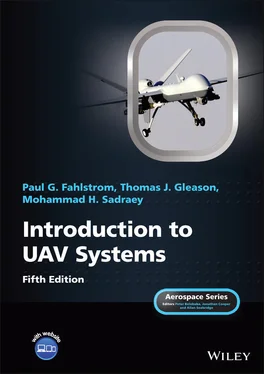The first real use of UAVs by the United States in a combat reconnaissance role began during the Vietnam War. UAVs, such as the AQM‐34 Firebee developed by Teledyne Ryan, were used for a wide range of missions, such as intelligence gathering, decoys, and leaflet dropping.
During the Vietnam War era, UAVs were used extensively in combat, but for reconnaissance missions only. The air vehicles were usually air launched from C‐130’s and recovered by parachute. The air vehicles were what might be called deep penetrators and were developed from existing target drones.
The impetus to operations in Southeast Asia came from activities during the Cuban Missile Crisis when UAVs were developed for reconnaissance but not used because the crisis ended before they became available. One of the first contracts was between Ryan and the Air Force, known as 147A, for vehicles based on the Ryan Firebee target drone (stretched versions). This was in 1962 and they were called Fireflys. Although the Fireflys were not operational during the Cuban crisis, they set the stage for Vietnam. Northrop also improved their early designs, which were essentially model airplanes, to jet‐propelled deep penetrators, but stuck mostly to target drones. The Ryan Firefly was the primary air vehicle used in Southeast Asia.
A total of 3,435 sorties were flown, and most of these (2,873, or nearly 84%) were recovered. One air vehicle, the TOMCAT, successfully completed 68 missions before it was lost. Another vehicle completed 97.3% of its missions of low‐altitude, real‐time photography. By the end of the Vietnam War in 1972, air vehicles were experiencing 90% success rates [1].
At the end of the Vietnam War, general interest in UAVs dwindled until the Israelis neutralized the Syrian air defense system in the Bekaa Valley in 1982 using UAVs for reconnaissance, jamming, and decoys. The Israeli Air Force pioneered several UAVs in the early 1980s. In 1982, United States observers noted Israel’s use of UAVs in Lebanon and persuaded the Navy to acquire a UAV capability. One of the early UAVs acquired by the Navy was the RQ‐2 Pioneer. It was developed jointly by AAI Corporation and Israeli Aircraft Industries and became a very useful air vehicle during Desert Storm for collecting tactical intelligence.
Actually, the Israeli UAVs were not as technically successful as many people believe, with much of their operational success being achieved through the element of surprise rather than technical sophistication. The air vehicle was basically unreliable and couldn’t fly at night, and the data‐link transmissions interfered with the manned fighter communications. However, they proved that UAVs could perform valuable, real‐time combat service in an operational environment.
The United States began to work again on UAVs in August 1971 when the Defense Science Board recommended mini‐RPVs for artillery target spotting and laser designation. In February 1974, the Army’s Material Command established an RPV weapons system management office and by the end of that year (December) a “Systems Technology Demonstration” contract was awarded to Lockheed Aircraft Company, with the air vehicle subcontracted to Developmental Sciences Incorporated (later DSC, Lear Astronics, Ontario, CA). The launcher was manufactured by All American Engineering (later ESCO‐Datron), and the recovery net system by Dornier of the then still‐partitioned West Germany. Ten bidders competed for the program. The demonstration was highly successful, proving the concept to be feasible. The system was flown by Army personnel and accumulated more than 300 flight hours.
In September 1978, the so‐called Target Acquisition/Designation and Aerial Reconnaissance System (TADARS) required operational capability (ROC) was approved, and approximately 1 year later, in August 1979, a 43‐month Full Scale Engineering Development (FSED) contract was awarded to Lockheed as the sole source. The system was given the name “Aquila” and is discussed in more detail at the end of this chapter. For a number of reasons that provide important lessons to UAV system developers, Aquila development stretched out for many years and the system was never fielded.
In 1984, partly as a result of an urgent need and partly because the Army desired some competition for Aquila, the Army started a program called Gray Wolf, which demonstrated, for the first time for a UAV, hundreds of hours of night operations in what could be called “combat conditions.” This program, still partly classified, was discontinued because of inadequate funding.
The US Navy and Marine Corps entered the UAV arena in 1985 by purchasing the Mazlat/Israeli Aircraft Industries (IAI) and AAI Pioneer system, which suffered considerable growing pains but still remains in service. However, Congress by this time became restless and demanded that a joint project office (JPO) be formed so that commonality and interoperability among the services would be maximized. The JPO was put under the administrative control of the Department of the Navy. This office has developed a master plan that not only defines the missions but also describes the desirable features for each kind of system needed by the services. Some elements of this plan will be discussed in Chapter 2in the section called “Classes of UAV Systems.”
The US Air Force was initially reluctant to embrace UAVs, notwithstanding their wealth of experience with target‐drone unmanned aircraft. However, this attitude changed significantly during the 1990s and the Air Force not only has been very active in developing and using UAVs for a variety of purposes but also has been the most active of the four US services in attempting to take control of all UAV programs and assets within the US military.
The invasion of Iraq to Kuwait in 1990–1991 allowed military planners an opportunity to use UAVs in combat conditions. They found them to be a highly desirable asset even though the performance of the systems then available was less than satisfactory in many ways. Five UAV systems were used in the operation: (1) the Pioneer by US forces, (2) the Ex‐Drone by US forces, (3) the Pointer by US forces, (4) the “Mini Avion de Reconnaissance Telepilot” (MART) by French forces, and (5) the CL 89, a helicopter UAV, by British forces.
Although numerous anecdotal stories and descriptions of great accomplishments have been cited, the facts are that the UAVs did not play a decisive or a pivotal role in the war. For example, the Marines did not fire upon a single UAV‐acquired target during the ground offensive according to a Naval Proceedings article published in November 1991 [2]. What was accomplished, however, was the awakening in the mind of the military community of a realization of “what could have been.” What was learned in Desert Storm was that UAVs were potentially a key weapon system, which assured their continuing development.
The NATO UAV operation in Bosnia was one of surveillance and reconnaissance. Bomb‐damage assessment was successfully accomplished after NATO’s 1995 air attacks on Bosnian‐Serb military facilities. Clearly shown in aerial photographs are Serbian tanks and bomb‐damaged buildings. Night reconnaissance was particularly important as it was under the cover of darkness that most clandestine operations took place. The Predator was the primary UAV used in Bosnia, flying from an airbase in Hungary.
1.2.7 Afghanistan and Iraq
The war in Iraq (which lasted from 2003 to 2011) has transformed the status of UAVs from a potential key weapons system searching for proponents and missions to their rightful place as key weapon systems performing many roles that are central to the operations of all four services. At the beginning of the war, UAVs were still under development and somewhat “iffy,” but many developmental UAVs were committed to Operation Iraqi Freedom.
Читать дальше












